

Last Chair: The Ski Utah Podcast
Ski Utah
Ski Utah's new Last Chair will take you inside Utah's resorts for the story behind the Greatest Snow on Earth®. In a weekly series of audio features, host Tom Kelly will bring you behind the scenes with resort leaders, athletes and fascinating figures who are the stories inside Utah skiing and snowboarding. Whether you're a passionate local snow rider, or a guest to the Utah mountain landscape, you'll learn about mountain life through the stories of the men and women who shape the Ski Utah experience. Each Last Chair episode is 30-40 minutes, with insightful questions and fun anecdotal facts. As a career communicator, Kelly weaves stories with ease bringing listeners inside the mountain tales of Utah skiing and snowboarding.
Episodes
Mentioned books
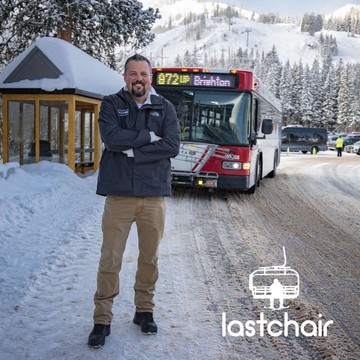
Jan 22, 2025 • 38min
SE6EP6- Express Route to Resorts with the UTA Ski Bus
On this episode, Last Chair grabbed veteran UTA ski bus driver Doug Malmborg for a ride on the 972 line up to Solitude and Brighton. Malmborg shared his vast knowledge of the UTA ski bus service, plus some fascinating ski and mining history that he has gleaned growing up in the Cottonwoods.
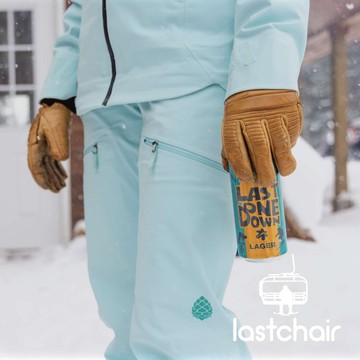
Dec 19, 2024 • 39min
SE6EP5 - David Miller: Sustainable Approach to Brewing Beer
David Miller, director of operations at Ski Utah partner Wasatch Squatters Brewing, has long had a passion for brewing beer. But also for doing it in a sustainable way. The popular Utah brewery, born in the resort town of Park City in 1986, has put innovative practices in place to recycle cans, used grain, water, and more. Last Chair headed to the Wasatch Squatters taproom in Salt Lake City to get insights from Miller and to enjoy a Last One Down lager, a beer brewed in partnership with Ski Utah.Miller grew up in Oklahoma – not exactly ski destination. But his parents were Colorado skiers, so the family often hit small hills in New Mexico with a few trips north to the Rocky Mountains of Colorado. His passion for brewing first played out when he volunteered to help out at Oklahoma’s Prairie Artisan Ales. His brewery journey took him to North Carolina and then Dallas. While in Texas, his boss was in Utah, and the lure of the Wasatch – both the brewery and the mountains – brought him to Salt Lake City just a few years ago. He sees the mountains as a great place to raise a family, and his young kids are already ripping around Solitude.But as much as he loves brewing, his real passion is being a steward of the planet on which we live. It’s ingrained in Miller’s life, from the lessons he teaches his young kids to the practices he puts in place at Wasatch Squatters.“Sustainability does not always come easy – it's not just a flip of a switch,” said Miller. “So if we're able to do something more efficient and more sustainable, even though it may be really hard to do, we're going to take that challenge on.” It’s mid-day at the Wasatch Squatter’s taproom as guests slide up to the bar for a lunchtime brew. Meanwhile, Miller is diving deeper into the myriad ways Wasatch Squatters is creating ways to innovate its operation to be more sustainable.It’s about finding an effective way to recycle cans that are kicked off the bottling line. Or reusing water used to cool hot tanks during the process. Or finding a new home for the tons of grain used during brewing – which makes for some happy cattle on Utah ranches. Wasatch Squatters also substitutes nitrogen for carbon dioxide.“I couldn't imagine being part of an industry that didn't care about this,” said Miller.The conversation often swings back to his kids, who have learned early the importance of loading up the truck with cans to take to recycling. “I have two boys and just instilling sustainability practices in them is really important to my wife and I. And they’re already taking note of it – throwing their banana peels in the compost pile.”Those practices carry over to their day-to-day life, including their time on snow up in the Cottonwoods.“Every time I’m on the slopes with my family, I know I have to take care of this place. I pick up that piece of trash or recycle that piece of cardboard. And that carries through our business. And we know we’ve got a lot of people who get up on the mountain who have the same mindset – which is great.”Beer is a part of the culture of skiing. This episode of Last Chair takes you inside the brewery to learn about how Wasatch Squatters keeps sustainability a key priority. And while the sustainability practices at the brewery are on a high level, Miller easily relates them to things each of us can do ourselves. So grab a Wasatch Last One Down and enjoy this conversation with David Miller.

Dec 6, 2024 • 42min
SE6EP4 - Steven Clark: Avalanche Safety on Cottonwood Highways
Steven Clark enjoyed the ideal skier’s lifestyle as a young boy living at the mouth of the Cottonwood Canyons. Today, he’s the avalanche safety program manager for the Utah Department of Transportation (UDOT). As skiers and riders wind their way up Little Cottonwood Canyon, one of the most avalanche-intensive sections of highway in the world, he’s the one leading efforts to help keep us safe. Clark joined this episode of Last Chair from Snowbird to talk about innovative new technology that is helping to keep avalanche safety workers – and all of us on the highway – safe during winter storms.Many of us think about backcountry avalanche safety. Clark himself, when he was young, had the Utah Avalanche Center phone number posted on the family’s home phone. But it’s doubtful many of us think a lot about avalanches as we travel mountain highways every winter. We think about the plows that clear the roadway for us. But what’s up above might be largely out of our minds as we wind up State Route 210 for eight miles towards Snowbird and Alta.In those eight miles from the mouth of Little Cottonwood Canyon up to Alta, there are 64 identified, named avalanche paths that can impact the highway. While the ski resorts all manage avalanche safety in their boundaries, it’s up to UDOT to mitigate the danger on the highway. From howitzers to hand charges, UDOT avalanche safety teams work to keep all highways in the state safe for drivers and residents.For around 75 years military howitzers have played a pivotal role, lobbing shells across valleys to dislodge snowpack before it poses a danger to the highway. In 2007, UDOT began to look at alternatives to lobbing shells through the air. Today, howitzers are being phased out. As an example, in 2023 Alta retired its 105-mm cannon that had fired thousands of rounds of shells since being introduced in the 1950s by avalanche safety legend Monty Atwater.Replacing the howitzers is an array of remotely triggered devices installed on mountainside towers throughout the canyon. Towers from Wyssen Avalanche Control can be remotely activated to drop charges into the snow. Installations from GAZEX™ create a controlled explosion from which the concussive force triggers a slide. UDOT is using both systems, with new installations around Mount Superior will be in operation this season. There are now nearly 90 remotely-activated avalanche mitigation installations in the canyon between UDOT and the ski resorts. The new systems provide yet another level of public safety, eliminating the need to fire shells across the valley or to have avalanche safety workers conduct high-risk operations. In addition, UDOT employs a sophisticated array of avalanche sensors to analyze the snowpack and provide valuable feedback and updates.This episode of Last Chair provides some fascinating insights into the work done behind the scenes to keep us safe as we travel the Cottonwood Canyons to ski and ride. A well-known figure in the Utah snow safety community, Steven Clark is a great example of the dedication of the UDOT team that helps keep us safe.
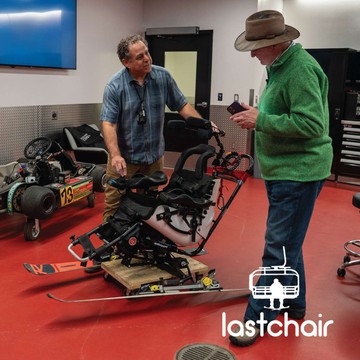
Nov 21, 2024 • 43min
SE6EP3: Tetraski
When Dr. Jeffrey Rosenbluth left med school for his first job at the University of Utah in 2001, he already had a vision in mind. A skier himself, he wanted to bring that wind-in-your-face sensation of the sport to those who didn’t have the same personal mobility. Fast forward to today, Dr. Rosenbluth's pioneering initiative has led to TetraSki – a device that combines medical science with engineering to create remarkable opportunities for individuals with physical disabilities.In this episode of Last Chair, we head to the Mobility Garage of the University of Utah’s Craig H. Neilsen Rehabilitation Hospital, speaking with Dr. Jeffrey Rosenbluth, along with program director of TRAILS Adaptive Tanja Kari, a six-time Paralympic champion cross country skier who was one of the heroes of the 2002 Paralympic Winter Games in Utah.TetraSki is truly a revolutionary mobility tool in sport. It features a customized chair attached to a pair of Rossignol skis. The engineering brains of TetraSki allow the operator to control the skis through a simple joystick. And if the skier doesn’t have the body functionality to manipulate the joystick, there’s a breathing tube – blow in or suck out, and the skis respond. A new innovation can also be attached to a functioning muscle, where muscular reflects are converted into ski movement.Yes, this is real! And there are now around two dozen TetraSkis around the world, providing mobility opportunities to those who might never have conceived that they might ski.Growing up in Los Angeles, Rosenbluth would always look for opportunities to get up to Utah for skiing. Wanting to spend his career in spinal cord injury medicine, when he saw a job opportunity in Salt Lake City he jumped at it.“After the first couple of years of getting settled here, it was obvious that we had this really tight, enthusiastic campus – people with engineering backgrounds and clinical backgrounds, other scientific backgrounds, and then the access to the outdoors is just unprecedented,” he recalled. “I don't think there's another academic center that has this. So there was just an obviousness to where we were heading and getting people excited about building new devices and getting out there and trying new programs – that was an easy sell.”Early in his tenure, he created TRAILS Adaptive – an acronym combining technology, recreation, access, independence, lifestyle, sports. TRAILS provided the first pathway to provide wellness programs and real opportunities for individuals. Kari was a young Finnish cross country skier when she visited Utah for the first time at the 2002 Winter Games. What stood out to her was that the same organizing committee managed both the Olympics and Paralympics – the first time ever! “We felt the difference in the Games for that,” she said, “in the level of expertise and perfectionism. It was just unbelievable for us.” Three years later, she found her way back and has now made Utah her home.She found a home at TRAILS Adaptive for very similar reasons. “As a Paralympian and being involved in this world for a long time in different roles, the fact that we have this mentality and space in the rehabilitation hospital – being able to meet those patients right when they're here with us and sharing the methods of active living – is really important to me.”It’s easy to geek out at the engineering in TetraSki today. However, the brilliance behind it goes back 20 years as Dr. Rosenbluth began mapping out the vision he brought from med school. “It was just this recognition that you couldn't just open up shop with just sports,” he said. “You had to really think about advocacy. You had to think about sports deeper than just participation – how could you be as independent at that sport as possible? And what if you didn't have transportation? You'd never be able to come and do the sport.“I thought at first we were really more of a think tank, going through all the different ways we could take folks, especially with more complex disabilities, and get them to participate more frequently to create life sports for some of our complex patients – and then do it at the highest level of independence and performance.”Ski Utah’s Last Chair podcast with Dr. Jeffrey Rosenbluth and Tanja Kari takes you inside one of the most innovative labs in the sport. It’s a fascinating – and emotional – journey showcasing the work being done at the University of Utah to provide the gift of skiing to those who can’t click into their bindings the same way that we do.
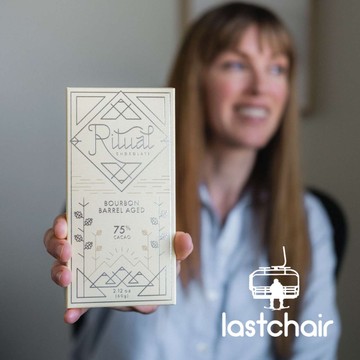
Oct 22, 2024 • 1h 1min
SE6EP2 - Whiskey & Chocolate
Holly Booth, Beverage Manager at High West Distillery, Anna Seear, President of Ritual Chocolate, and Kayla Gaseau, Sensory Manager at High West, delve into the delightful marriage of whiskey and chocolate. They discuss the innovative process of aging chocolate in whiskey barrels, creating unique flavor profiles. Listeners learn about the evolution of the local distilling scene, exciting pairings, and the spirit of the American West. The trio also share personal adventures in Utah’s stunning outdoors, enhancing the experience of these artisanal treasures.
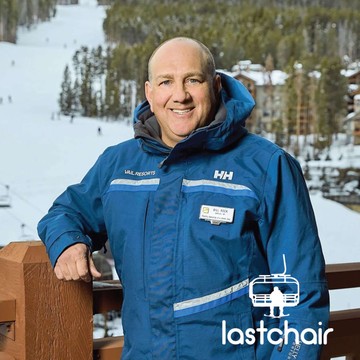
Oct 9, 2024 • 56min
SE6EP1 - Bill Rock: An Epic Career on the Mountain
Bill Rock is at home on the mountain. He skis. He snowboards. He remembers that first day his kids passed him on a ski run. He counts his blessings for being able to spend his life on ski mountains around the country – around the world! Today, as president of the mountain division of Vail Resorts, he is one of the most influential leaders in our sport. In his conversation with Ski Utah’s Last Chair podcast, he talks about the evolution of his career and the pride he takes in his company’s innovations to improve the guest experience.
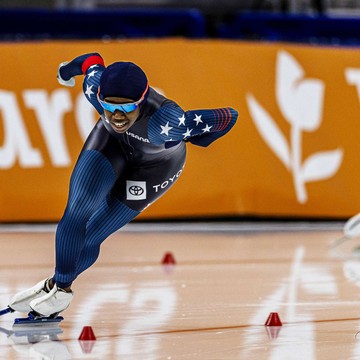
Jul 24, 2024 • 1h 3min
SE5:EP11 - Winter Games Returning to Utah in 2034
It’s now official! The Olympic and Paralympic Winter Games are returning to Utah in 2034. The International Olympic Committee made the call on July 24. In this episode of Last Chair, we’ll explore the games to come looking at a few venues outside of the traditional skiing and snowboarding realm.With all of the 2002 Olympic venues still in place and operating, the 2034 edition will require no permanent venue construction. The IOC welcomed this sustainable approach. In 2034, around a dozen venues will be used—all within an hour’s drive of the Athlete Village on the University of Utah campus in Salt Lake City.The caretaker of many of the venues is the Utah Olympic Legacy Foundation. President and CEO Colin Hilton talks about the Utah Olympic Park, with its bobsled, skeleton, and luge sliding track, as well as the towering ski jumps. Hilton also oversaw the assembling of all venues for the 2034 bid and will give an overview of what we can expect.One of the most popular Olympic sports today is biathlon – an unusual combination of cross country skiing and marksmanship. Utah native Vincent Bonacci, a member of the U.S. Biathlon Team, will talk about the sport, its uniqueness and why the Soldier Hollow Nordic Center is such a vital venue.We’ll then head to the sliding track at the Utah Olympic Park – known as one of the fastest in the world. Utah native Kaysha Love will talk about how she went from a top-tier high school and collegiate sprinter to becoming one of the best bobsledders in the world in just a few years.Finally, we’ll talk about winning Olympic gold with 500m long-track speedskating star Erin Jackson. A Florida native, Jackson talks about her transition from inline skating to ice, tells the story about her improbable journey to Beijing to win gold, and relates (with a smile) her weekend ski experience at Deer Valley Resort.
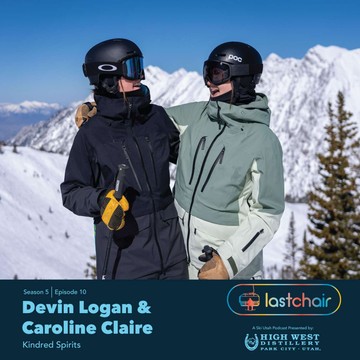
May 2, 2024 • 54min
SE5EP10 - Devin Logan & Caroline Claire: Kindred Spirits
Olympians Devin Logan and Caroline Claire are kindred spirits, finishing each other’s sentences and sharing a common passion for hucking themselves off jumps and poofing through powder pillows in the Little Cottonwood backcountry. So how did the two Long Island girls, seven years apart in age, find each other and make their way to Utah? The duo are now telling their story through the lens of filmmakers Sarah Beam Robbins and Iz La Motte in Kindred, set to premier this fall. Last Chair caught up with them on a bluebird day at Alta to hear their story.
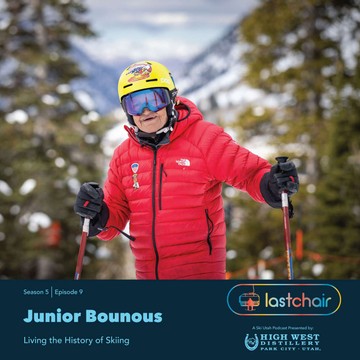
Mar 19, 2024 • 1h 15min
SE5:EP9 - Junior Bounous: Living the History of Skiing
Join Ski Utah's Last Chair as they chat with legendary skier Junior Bounous, who shares 53 seasons of skiing history in Utah, from designing runs at Snowbird for Ted Johnson to his mentorship under Alf Engen. Discover how he transformed ski education and introduced powder skiing to the world, all while still hitting the slopes at 98 and a half years old.
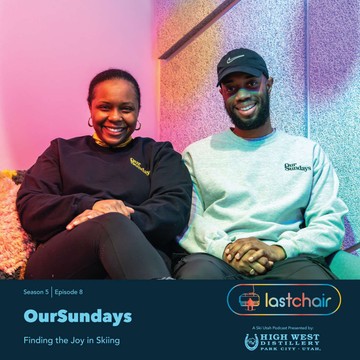
Feb 24, 2024 • 52min
SE5:EP8 - OurSundays: Finding the Joy in Skiing
A big part of the history of skiing is the fellowship of ski clubs. And before you write it off as a thing of the past, meet the OurSundays Ski & Board Club. This started out to be a podcast on diversity, exploring OurSundays’ affiliation with the National Brotherhood of Snowsports. But it quickly became a celebration of why we all love to ski and ride – a culture shared by all. Domeda Duncan and Mark Giles are two transplants to Utah. Domeda skied as a child in Detroit. The closest Mark came to the sport was on a jet ski in Florida. But as new Utahns, they both wanted to explore winter in the mountains on skis. After all, wasn’t that what Utah was about?Ski Utah’s Discover Winter program provided that opportunity.Born out of the Black Lives Matter movement in 2020, Discover Winter is now in its third season. Ski Utah made a unique decision to focus its diversity program on adults. Domeda and Mark are prime examples of how it has worked. If you’re a longtime skier or rider, chances are that as much as you love the sport, there are aspects that you take for granted. Hang out with the OurSundays gang, and they’ll remind you that, at its core, skiing and snowboarding are about social engagement. It’s the sizzle of the bacon alongside the buttermilk pancakes in the Brighton parking lot as the first rays of sun glint off Milly. Or it’s karaoke after a joyous day on the slopes. As Domeda says, it brings out the best in all of us.The new OurSundays club is now a part of the National Brotherhood of Snowsports, a nationwide organization of Black ski clubs that recently celebrated its 50th anniversary. Formed by Hall of Famers Ben Finley and Art Clay, it blossomed over the years with its Black Summit, widely known as the most fun week in skiing. Domeda’s own roots in the sport trace back to the Jim Dandy Ski Club, one of the founding programs of NBS.Industry leaders, like Ski Utah, have long grappled with how to make the sport more inviting for people of color. We could all learn a few things from OurSundays. Listen in to this Last Chair conversation with Mark Giles and Domeda Duncan. It’s an enlightening look at why we all love the culture of skiing and snowboarding. And if you run into Domeda on the slopes, ask her for that buttermilk pancake recipe. Now settle in for this episode of Last Chair.


